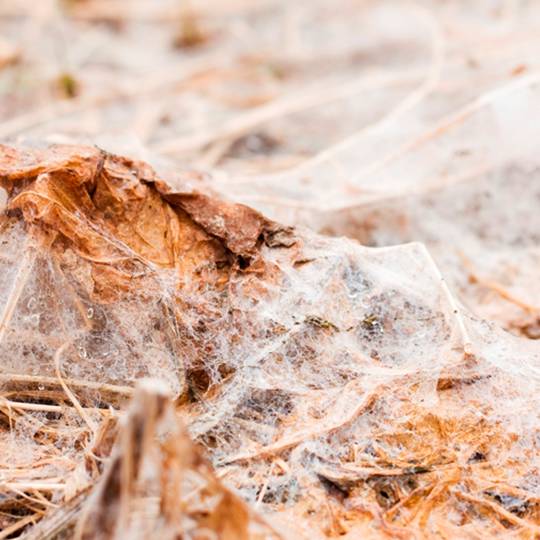
Grasses most commonly affected: Most grasses including annual bluegrass, Kentucky bluegrass, and bentgrass.
What Is Snow Mold?
Snow mold, also known as snow rot, is a type of fungal lawn disease that forms when snow cover or wet leaves remain on the lawn too long. Although it is active during the winter months, the damage becomes visible in the spring as the snow melts. It can affect almost any type of grass that has to endure cold temperatures and snow cover, and if left untreated, can cause ongoing damage to the lawn.
There are two types of snow mold: pink or Fusarium patch (Microdochium nivale) and gray or Typhula blight (Typhula incarnata). Gray snow mold tends to damage only the blades of the grass system, while the pink type, the more severe form of snow mold, can cause more damage by destroying the roots and crowns of the grass.
Snow Mold Signs and Symptoms
Often found growing side by side, pink and gray snow molds are visually similar in their web-like appearance, but operate a little differently. Gray snow mold only occurs under snow cover, while its pink relative grows under snow cover as well as without snow during periods of cool, damp weather. Symptoms first appear in the lawn as a series of circles that can range from 3 to 12 inches in diameter. These matted, brownish colored patches start to appear as the snow melts in the spring and will keep growing as long as the ground stays cold and wet.
Snow Mold Prevention
Snow mold is dormant during the warmer months, so it is best to take preventative steps at the end of the summer. Healthy lawn maintenance including routine mowing, leaf raking, and a proper fertilization program will keep you one step ahead of this disease.
Some steps you can take to prevent snow mold:
- Mow your lawn well into the fall, after the growing season, and make certain the last mowing cuts grass especially short. (Long grass compacted under snow gives the fungus a perfect place to incubate.)
- Rake and mulch leaves regularly in the fall to prevent them from piling up on the lawn for too long.
- Reduce any long-standing piles of snow in shady areas.
- Nitrogen can stimulate the growth of snow mold, so when feeding your lawn it is best to use a low-nitrogen, slow-release fertilizer.
- Applying chemicals to already infested areas will do little to help the damage that has already occurred. The time to apply fungicides is in the late fall, before the first large snowfall, as a preventative step.
To control snow mold on your lawn, contact Cardinal Lawns today. We provide thorough lawn disease control and unparalleled expertise to help your property look its best.
Need Help with Snow Mold?
Call Cardinal Lawns today at 614-808-4446 and let's talk about how we can help treat for Snow Mold and other common Ohio lawn diseases.
Get a Free Quote